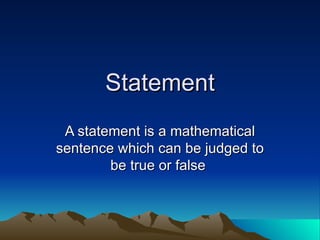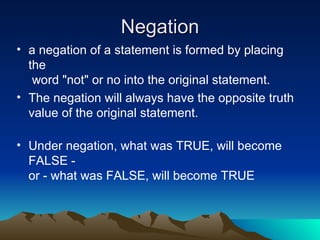Mathematical Reasoning
- 1. Statement A statement is a mathematical sentence which can be judged to be true or false
- 2. Example âGarfield is a cartoon character." a true statement. "A pentagon has exactly 4 sides." is a false statement. "Did you get that one right?" Not a statement âStop the bus.â Not a statement
- 3. Quantifiers Words that indicate number of objects or cases referred to in a statement. Example : All, Every, Any Some, Several, One of, part of
- 4. Examples â True Statements All squares have 4 sides Some kites have one axis of symmetry All cows have 4 legs.
- 5. Examples â False Statement All girls like pink. All fractions are smaller than one
- 6. Construct a true statement using the quantifier âallâ or âsomeâ.
- 7. Negation a negation of a statement is formed by placing the  word "not" or no into the original statement. The negation will always have the opposite truth value of the original statement.  Under negation, what was TRUE, will become FALSE - or - what was FALSE, will become TRUE
- 8. Examples: 1. Original Statement:Â "15 + 20 equals 35."Â (is true) Negation:Â "15 + 20 does not equal 35."Â (is false) Â 2. "A dog is a cat."Â is a false statement. "A dog is not a cat." is a true statement.
- 9. Compound Statement A compound statement can be formed from 2 given statements using the word âandâ or âorâ. Examples : 3 is a prime number 3 is an odd number 3 is a prime and odd number.
- 10. Truth Value of a compound statement using âandâ a conjunction is a compound sentence formed by combining two statements (or facts) using the word "and."Â Â A conjunction is true only when BOTH statements (or facts) are true.
- 11. Examples: 1. "Blue is a color and 7 + 3 = 10." (T and T = T)     Since both facts are true, the entire sentence is true.  2. "One hour = exactly 55 minutes and one minute = exactly 60 seconds."     (F and T = F) Since the first fact is false, the entire sentence is false. 3. "3 + 4 = 6 and all dogs meow." (F and F = F)     Since both facts are false, the entire sentence is false.
- 12. Truth Value of a compound statement using âorâ a disjunction is a compound sentence formed by combining two statements (or facts) using the word "or."Â A disjunction is true when EITHER or BOTH sentences (or facts) are true.
- 13. Examples: 1. "Blue is a color or 7 + 3 = 10." (T or T = T) Since both facts are true, the entire sentence is true.   2. "One hour = exactly 55 minutes or one minute = exactly 60 seconds." (F or T = T) Since the second fact is true, the entire sentence is true.  3. "3 + 4 = 6 or all dogs meow." (F or F = F) Since both facts are false, the entire sentence is false.  4.  "The word cat has 3 letters or the word dog has four letters." (T or F = T) Since the first fact is true, the entire sentence is true.














